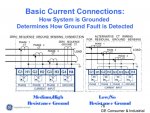electrofelon
Senior Member
- Location
- Cherry Valley NY, Seattle, WA
Looking for a little clarification here. I am not real familiar with these systems, in fact this is the first time I have installed a new service or SDS with GFPE. Up till now, I always seem to get around the requirement by using MLO's with multiple service disconnects.
We have a 3000 amp switchboard with a 3000 amp BPS main. This is actually a SDS not a service. The Unit was all factory built and assembled. After pulling the feeders, I was getting set to make terminations. I knew it was a GFPE system so I began to look at the equipment in more detail to make sure I was landing the neutrals and ground on the proper busses. There is a CT on each phase, but not one on the system bonding jumper. I assume that makes this a zero sequence type not a residual type correct? What I am confused by is there is a sticker near the neutral buss that reads "do not land any grounding conductors on this buss or GFP will be defeated." Was this sticker erroneously applied as it seems this would only apply to a residual GFP system, correct? I would appreciate some clarification. Thanks.
We have a 3000 amp switchboard with a 3000 amp BPS main. This is actually a SDS not a service. The Unit was all factory built and assembled. After pulling the feeders, I was getting set to make terminations. I knew it was a GFPE system so I began to look at the equipment in more detail to make sure I was landing the neutrals and ground on the proper busses. There is a CT on each phase, but not one on the system bonding jumper. I assume that makes this a zero sequence type not a residual type correct? What I am confused by is there is a sticker near the neutral buss that reads "do not land any grounding conductors on this buss or GFP will be defeated." Was this sticker erroneously applied as it seems this would only apply to a residual GFP system, correct? I would appreciate some clarification. Thanks.



